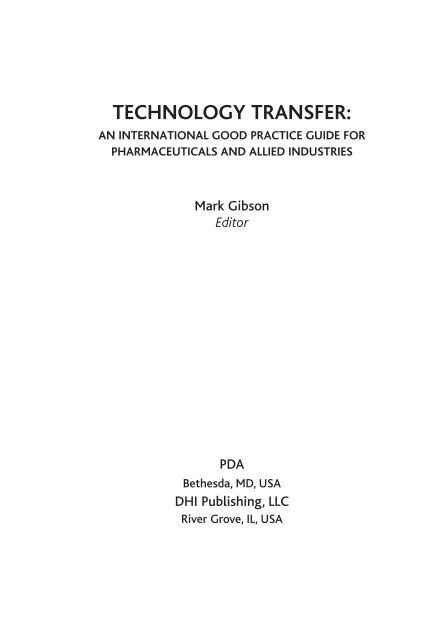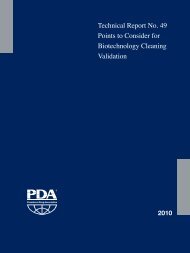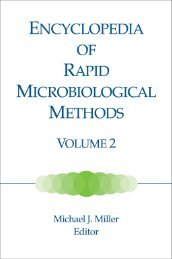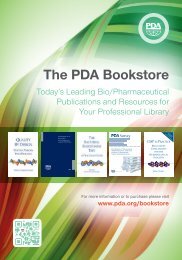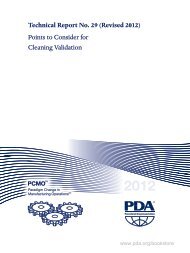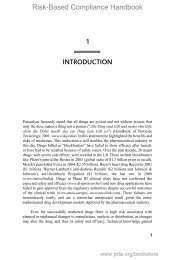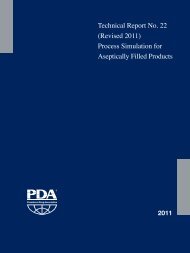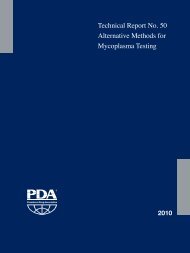TECHNOLOGY TRANSFER: - Parenteral Drug Association
TECHNOLOGY TRANSFER: - Parenteral Drug Association
TECHNOLOGY TRANSFER: - Parenteral Drug Association
Create successful ePaper yourself
Turn your PDF publications into a flip-book with our unique Google optimized e-Paper software.
<strong>TECHNOLOGY</strong> <strong>TRANSFER</strong>:<br />
AN INTERNATIONAL GOOD PRACTICE GUIDE FOR<br />
PHARMACEUTICALS AND ALLIED INDUSTRIES<br />
Mark Gibson<br />
Editor<br />
PDA<br />
Bethesda, MD, USA<br />
DHI Publishing, LLC<br />
River Grove, IL, USA
10 9 8 7 6 5 4 3 2 1<br />
ISBN: x-xxxxxx-xx-x<br />
Copyright © 2005 Mark Gibson. All rights reserved.<br />
All rights reserved. This book is protected by copyright. No part of it may be reproduced, stored in a<br />
retrieval system or transmitted in any means, electronic, mechanical, photocopying, recording, or otherwise,<br />
without written permission from the publisher. Typeset in the United Kingdom by Dolffin. Printed in the United<br />
States of America.<br />
Where a product trademark, registration mark, or other protected mark is made in the text, ownership of<br />
the mark remains with the lawful owner of the mark. No claim, intentional or otherwise, is made by reference to any<br />
such marks in the book.<br />
While every effort has been made by the publisher and the author to ensure the accuracy of the<br />
information contained in this book, the organization accepts no responsibility for errors or omissions. The views<br />
expressed in this book are those of the editors and authors and may not represent those of either Davis Healthcare<br />
International or the PDA, its officers, or directors.<br />
PDA<br />
3 Bethesda Metro Center<br />
Suite 1500<br />
Bethesda, MD 20814<br />
United States<br />
301-986-0293<br />
Davis Healthcare International Publishing, LLC<br />
2636 West Street<br />
River Grove<br />
IL 60171<br />
United States<br />
www.DHIBooks..com
CONTENTS<br />
Contents iii<br />
Preface xi<br />
List of Abbreviations xiii<br />
1. Technology Transfer Introduction and Objectives 1<br />
Mark Gibson<br />
Purpose of the Book 1<br />
Technology Transfer and the <strong>Drug</strong> Discovery and Development Process 1<br />
Why is Technology Transfer Important? 6<br />
Scope of the Book 7<br />
References 11<br />
2. Technology Transfer: The Regulatory and Business Perspective 13<br />
Alan Harris and Siegfried Schmitt<br />
Introduction 13<br />
Regulatory Requirements for Technology Transfer 13<br />
Safety, Health and Environmental (SHE) Regulations 15<br />
General Safety and Health Considerations 16<br />
Waste Disposal 16<br />
POTENTIAL IMPACT OF NOTIFICATION OF NEW<br />
SUBSTANCES (NONS) REGULATIONS 17<br />
Economic Factors 18<br />
Technology 19<br />
Social Aspects and the Impact on Technology Transfer 20<br />
Language 20<br />
Culture 21<br />
Team Building 22<br />
Conclusions 23<br />
References 24<br />
iii
iv<br />
Contents<br />
3. Technology Transfer: Organisation Strategy and Planning 25<br />
Steve Burns and Mark Gibson<br />
Introduction 25<br />
Stages of the Technology Transfer Process 26<br />
Stage 1: Pre-technology Transfer Preparation 26<br />
Technology Transfer Strategies 29<br />
Stage 2: Scale-up and Establish Process at Commercial Scale 32<br />
Stage 3: Plan and Perform Process Validation 33<br />
Management of Change 34<br />
Organisation 34<br />
Teams Supporting the Technology Transfer Process 36<br />
Global Technology Transfer Management Team (GTTMT) 36<br />
Sending Site (R&D) <strong>Drug</strong> Substance Project Team 38<br />
Sending Site (R&D) <strong>Drug</strong> Product Project Team 38<br />
Receiving Sites(s) Project Teams 40<br />
Documentation Required to Support Technology Transfer 41<br />
Planning 42<br />
Timings 44<br />
References 46<br />
Acknowledgements 46<br />
4. Training: An Essential Element of Technology Transfer 47<br />
Siegfried Schmitt<br />
Introduction 47<br />
Learning from Technology Transfer 48<br />
Developing a Training Strategy 48<br />
Scope of Training 49<br />
Prioritisation and Context of Training Needs 49<br />
Detailed Contents of Training Programmes 50<br />
Methods and Tools for Delivering Training 51<br />
Management of Training Programmes 52<br />
Trainers 52<br />
Templates and Style Guidelines 53<br />
Training Documentation 53<br />
Language Used for Training Programmes 53<br />
Measuring the Success of Training 54<br />
Auditing of Training 54<br />
Conclusions 54
Contents v<br />
5. <strong>Drug</strong> Substance Development and Technology Transfer 57<br />
Alan Harris<br />
Introduction 57<br />
THE DRUG SUBSTANCE DEVELOPMENT PROCESS 57<br />
Introduction to <strong>Drug</strong> Substance Process Research and Development 57<br />
The Role of Process R&D 59<br />
Good Process Design 60<br />
Introduction to Technology Transfer for API 63<br />
Aims of Technology Transfer 65<br />
The Impact of Technology Transfer Issues on<br />
Process Development Strategies 66<br />
Early Development Decisions 66<br />
Route Selection, Regulatory and Sourcing Strategies 67<br />
Process Freeze 68<br />
Potential Impact of Notification of New Substances (NONS)<br />
Regulations 68<br />
Applying Risk Analysis and Risk Management to Technology<br />
Transfer Decisions 69<br />
Managing the Technology Transfer Programme 70<br />
Principles for Technology Transfer 70<br />
The Technology Transfer Team 71<br />
Documentation to be Transferred or Generated during<br />
Technology Transfer and Establishment of the Process 72<br />
SUCCESS CRITERIA FOR <strong>TECHNOLOGY</strong> <strong>TRANSFER</strong> 73<br />
Process Validation 74<br />
Case Study 1: Remacemide Hydrochloride 75<br />
Early Process Evaluation 75<br />
Process Research and Development Work 77<br />
Early Technology Transfer of the Process for DPAP 77<br />
Second Source for DPAP 80<br />
Technology Transfer of the Final Stages of the Process 81<br />
Salt Selection, Polymorphism and Particle Size 81<br />
Lessons from Case Study 1 82<br />
Case Study 2: Sibenadet Hydrochloride 83<br />
Synthesis and Technology Transfer of the Benzothiazolone Amine<br />
Intermediate 84<br />
Synthesis and Technology Transfer of the Intermediate Benzoate Ester 86<br />
Technology Transfer of the Final Steps 88<br />
Control of Physical Form 89<br />
Crystallisation/Drying Issues 90<br />
Overall Lessons from Case Study 2 90<br />
FUTURE DIRECTIONS FOR PROCESS DEVELOPMENT AND<br />
THE IMPACT ON <strong>TECHNOLOGY</strong> <strong>TRANSFER</strong> 92<br />
Biopharmaceuticals 92
vi<br />
Contents<br />
Microwave and Ultrasonic Reactors 93<br />
Micro-reactor Technology and Continuous Processes 93<br />
Chromatographic Purification Techniques 93<br />
Overall Conclusions 94<br />
References 95<br />
Acknowledgments 97<br />
6. <strong>Drug</strong> Product Development and Technology Transfer 99<br />
Mark Gibson<br />
Introduction 99<br />
Product Design 100<br />
Product Optimisation 105<br />
Process Design and Optimisation 107<br />
Process Capability and Robustness 111<br />
Use of PAT to Aid Process Optimisation and Understanding 111<br />
Scale-Up and Technology Transfer 114<br />
Process Validation 116<br />
Clinical Trials Process Validation 116<br />
Cleaning Validation 117<br />
Process Validation of the Commercial Process:<br />
Acceptance by Production 119<br />
Post-Validation and Post-Regulatory Approval Changes 122<br />
Documenting the <strong>Drug</strong> Development Process 124<br />
<strong>Drug</strong> Product Technology Transfer Case Studies 126<br />
Case Study 1 126<br />
Learning Points from Case Study 1 130<br />
Case Study 2 130<br />
Learning Points from Case Study 2 132<br />
Case Study 3 132<br />
Learning Points from Case Study 3 134<br />
References 135<br />
7. Analytical Methodology and Specifications 137<br />
Kevin McKiernan and Mark Hindle<br />
Introduction 137<br />
Analytical Technology Transfer:<br />
What to do before Formal Transfer Starts 138<br />
Production QC Involvement during Method Validation 140<br />
Production QC Involvement Post Validation 141<br />
Analytical Technology Transfer:<br />
When does it Start and When does it Finish 142<br />
Principles of Analytical Methodology Transfer 144
Contents vii<br />
Comparative Testing 145<br />
Covalidation between Two Laboratories 145<br />
Method Validation at the Receiving Site 145<br />
Completion and Timing 146<br />
THE <strong>TECHNOLOGY</strong> <strong>TRANSFER</strong> PROCESS FOR ANALYTICAL<br />
METHODOLOGY AND SPECIFICATIONS 146<br />
Stage 1: Analytical Strategy 147<br />
Stage 2: Knowledge and Information Transfer 147<br />
Stage 3: Transfer Protocol 148<br />
Stage 4: Analytical Testing 148<br />
Stage 5: Summary Report 148<br />
STAGE 1: ANALYTICAL STRATEGY 150<br />
Analytical Method Transfer Team 150<br />
Analytical Transfer Strategy Document 151<br />
STAGE 2: KNOWLEDGE AND INFORMATION <strong>TRANSFER</strong> 153<br />
Information Package 154<br />
Knowledge Transfer 155<br />
Method Discussion and Review 155<br />
Training and Familiarisation 156<br />
Approval of Information Transfer Package 157<br />
STAGE 3: METHOD <strong>TRANSFER</strong> PROTOCOL 157<br />
Testing Design 159<br />
Analytical Sample Identification and Transportation 159<br />
Acceptance Criteria 161<br />
Use of Statistics 163<br />
Approval of Method Transfer Protocol 165<br />
STAGE 4: ANALYTICAL TESTING 165<br />
STAGE 5: SUMMARY REPORT 166<br />
Transfer Approval 167<br />
Post-Approval Changes 167<br />
Method Transfer: Potential Problems and How to Avoid Them 168<br />
A Good Quality Method 168<br />
Language and Culture 169<br />
Communication 170<br />
Documentation 171<br />
Procedures 172<br />
Timescales 172<br />
Practical Problems 173<br />
Acceptance Criteria 174<br />
Summary 174<br />
References 175
viii<br />
8. Pre-Approval Inspection and Launch 177<br />
Mark Gibson<br />
Introduction 177<br />
The PAI Process 178<br />
Common PAI Deficiencies 179<br />
PAI - What will be Inspected? 180<br />
PAI: How to Prepare? 183<br />
1. Documented PAI Policy 183<br />
2. Formation of PAI Preparation Team(s) 183<br />
3. Documentation, Data Review and Retrieval 185<br />
4. Write the Development History Reports 188<br />
5. Good Level of cGMP and Compliance 189<br />
6. Training and Awareness 191<br />
PAI and Launch 193<br />
Technology Transfer: Final Conclusions 193<br />
References 195<br />
Glossary of Common Terms, Abbreviations and Acronyms 197<br />
Author Biographies 217<br />
Index 221<br />
List of Tables<br />
Contents<br />
Table 1.1 Typical Examples of Preferred <strong>Drug</strong> Synthesis, Pharmaceutical<br />
and Biopharmaceutical Properties for Candidate <strong>Drug</strong>s 2<br />
Table 3.1 Proposed Team Representatives on Global Technology Transfer<br />
Management Team (GTTMT) 37<br />
Table 6.1 Typical Target Product Profile 103<br />
Table 6.2 Process Design Considerations 109<br />
Table 6.3 Immediate Release Film Coated Tablet 127<br />
Table 6.4 Process Equipment and Scale for IR Film Coated Tablet 128<br />
Table 6.5 Ophthalmic Solution 131<br />
Table 7.1 Example Analytical Methodology Suitability Checklist for<br />
Chromatographic Methods 139<br />
Table 7.2 Generic Roles and Responsibilities for Transfer Documentation 150<br />
Table 7.3 Summary of Transfer Requirements 152<br />
Table 7.4 Example of a Typical Transfer Matrix 160<br />
Table 8.1 Documentation Check List for PAI 187
Table 8.2 Typical Contents of the Development Report 190<br />
Table 8.3 Recommended Inspection Behaviour 192<br />
List of Figures<br />
Contents ix<br />
Figure 1.1 The <strong>Drug</strong> Discovery and Development Process and<br />
Technology Transfer 3<br />
Figure 3.1 Stages of Technology Transfer 27<br />
Figure 3.2 High Level Documentation to Support Technology Transfer 43<br />
Figure 5.1 The Process R&D Contribution to the Development Process 60<br />
Figure 5.2 Hypothetical Process for API Manufacture 64<br />
Figure 5.3 Medicinal Chemistry Synthesis of Remacemide Hydrochloride 76<br />
Figure 5.4 Final Manufacturing Process for Remacemide Hydrochloride 78<br />
Figure 5.5 Sibenadet Hydrochloride 84<br />
Figure 5.6 Synthesis of the Benzothiazalone Intermediate for Sibenadet<br />
Hydrochloride 85<br />
Figure 5.7 Technology Transfer Process for Intermediate (2) 86<br />
Figure 5.8 The Synthesis of the Benzoate Intermediate for Sibenadet<br />
Hydrochloride 87<br />
Figure 5.9 The Final Steps of the Sibenadet Hydrochloride Process 89<br />
Figure 6.1 Stages of Product Development and Technology Transfer 101<br />
Figure 6.2 Manufacturing Process for IR Film Coated Tablet 129<br />
Figure 6.3 Manufacturing Process for Ophthalmic Solution 131<br />
Figure 6.4 Manufacturing Process for Metered Dose Inhaler 133<br />
Figure 7.1 Options for Involvement of QC Group in Technology<br />
Transfer 141<br />
Figure 7.2 Flow Diagram of the Analytical Process 149
PREFACE<br />
In the early 1980's when I started my career in the pharmaceutical industry, I recall that<br />
Technology Transfer from R&D to Production did not attract the attention that it does<br />
today. This could be partly because the R&D and Production facilities were co-located<br />
on the same site for the majority of transfers in which I was involved. Pilot scale<br />
batches were made in the R&D facilities on one day and products requiring scale-up<br />
and commercial scale manufacture were undertaken in the Production plant on<br />
another. Technology transfer was a very informal process with few written guidelines<br />
and procedures. R&D and Production personnel were able to develop very good<br />
working relationships because they could easily spend a lot of time together and get to<br />
know each other well.<br />
A few years later, on moving to another pharmaceutical company the<br />
circumstances had changed. The R&D site I worked at was in an isolated location and<br />
technology transfers were to distant Production sites, often overseas. Establishing<br />
good communication and planning were essential for success. With the plethora of<br />
company acquisitions and mergers over the past 15 to 20 years resulting in fewer, but<br />
much larger pharmaceutical companies, there has been an increased need to transfer<br />
technology between R&D and Production sites across the globe in a cost efficient and<br />
effective way. Pharmaceutical companies have been under increasing pressure to speed<br />
products from R&D to the market. At the same time, the drug development and<br />
regulatory hurdles have increased, including the need to pass an FDA pre-approval<br />
inspection if the product was destined for the United States market. The timely and<br />
successful technology transfer of new <strong>Drug</strong> Substances, <strong>Drug</strong> Products and Analytical<br />
Tests between these sites is a prerequisite to product registration, approval and launch<br />
and so the importance of having a structured approach to drug development and<br />
technology transfer has become paramount.<br />
This book is intended to give a comprehensive overview and guide to the<br />
technology transfer process for pharmaceutical <strong>Drug</strong> Substance, <strong>Drug</strong> Product and the<br />
corresponding analytical tests and methods from R&D to Production. Each of the<br />
contributors has extensive personal knowledge and experience in this field and they<br />
xi
xii<br />
Preface<br />
have provided practical examples to explain the critical factors involved in achieving<br />
successful and effective technology transfers. Several of the contributors are from<br />
AstraZeneca, including myself, but the reader must not assume that this book only<br />
reflects the AstraZeneca way of doing technology transfer. Many of the contributors<br />
have worked for different pharmaceutical companies; have been involved in<br />
developing and reviewing internal company guidelines and in giving seminars and<br />
presentations externally on technology transfer. I am indebted to each of the<br />
contributors for giving up so much of their time to produce the specialist chapters in<br />
this book.<br />
This book should benefit practitioners working in the pharmaceutical and related<br />
industries from R&D, commercial Production and various other areas of responsibility<br />
such as; Project Management, Clinical, Regulatory Affairs and Quality Assurance.<br />
Finally, I would like to thank my wife Alison and three children, Laura, Joanna<br />
and David, for their patience and understanding whilst I have been preparing this book<br />
and for not being able to spend so much time with over the past few months.<br />
Mark Gibson<br />
December, 2004
LIST OF ABBREVIATIONS<br />
ANDA Abbreviated New <strong>Drug</strong> Application<br />
API Active Pharmaceutical Ingredient<br />
BIRA Business Interruption Risk Assessment<br />
BPC Bulk Pharmaceutical Chemical<br />
C of A Certificate of Analysis<br />
CBZ Benzyloxycarbonyl<br />
CD Candidate <strong>Drug</strong>s<br />
CBER Center for Biologic Evaluation and Research<br />
CDER Center for <strong>Drug</strong> Evaluation and Research<br />
CDS Chromatography Data System<br />
CDTP CD Target Profile<br />
CFR Code of Federal Regulations<br />
cGMP Current Good Manufacturing Practice<br />
CIP Clean-In-Place<br />
COG Cost of Goods<br />
CMC Chemistry, Manufacturing and Controls<br />
CMC Contract Manufacturing Organisation<br />
COPD Chronic Pulmonary Obstructive Disease<br />
COSHH Control of Substances Hazardous to Health<br />
CpK Process Capability Index<br />
CPMP Committee for Proprietary Medicinal Products<br />
CRO Contract Research Organisation<br />
CTA Clinical Trial Application<br />
CTD Common Technical Document<br />
DCC Dicyclohexyl Carbodiimide<br />
DMF <strong>Drug</strong> Master File<br />
DP <strong>Drug</strong> Product<br />
DPAP Diphenylpropylamine<br />
DPD <strong>Drug</strong> Product Device<br />
DQ Design Qualification<br />
DS <strong>Drug</strong> Substance<br />
xiii
xiv<br />
List of Abbreviations<br />
EEC European Economic Community<br />
EGMP European Good Manufacturing Practice<br />
EINECS European Inventory of Existing Commercial<br />
Chemical Substances<br />
EMEA European Agency for the Evaluation of Medicinal<br />
Products<br />
EP European Pharmacopoeia<br />
ER Electronic Record<br />
ES Electronic Signature<br />
FDA Food and <strong>Drug</strong> Administration<br />
FIP International Pharmaceutical Federation<br />
FP Finished Pack<br />
FTIM First Time In Man Studies<br />
GAMP Good Automated Manufacturing Practice<br />
GC Gas Chromatography<br />
GCP Good Clinical Practice<br />
GI Gastrointestinal<br />
GLP Good Laboratory Practice<br />
GMP Good Manufacturing Practice<br />
GTTMT Global Technology Transfer Management Team<br />
GxP European Good Practice<br />
HAZOP Hazard and Operability Studies<br />
HPLC High Performance Liquid Chromatography<br />
HSE Health and Safety Executive<br />
ICH International Conference on Harmonisation<br />
IMP Investigative Medicinal Product<br />
IND Investigational New <strong>Drug</strong><br />
INDA Investigational New <strong>Drug</strong> Application<br />
IP Intellectual Property<br />
IQ Installation Qualification<br />
ISPE International Society of Pharmaceutical Engineers<br />
ISO International Organisation for Standardisation<br />
JNDA Japanese New <strong>Drug</strong> Application<br />
JP Japanese Pharmacopoeia<br />
LIMS Laboratory Information Management Systems<br />
LOD Limit of Detection<br />
LOQ Limit of Quantification<br />
M&A Mergers and Acquisitions<br />
MA Marketing Authorisation<br />
MAA Marketing Authorisation Application<br />
MBR Master Batch Record<br />
MCA Medicines Control Agency<br />
MDI Metered Dose Inhaler
List of Abbreviations xv<br />
MHRA Medicines and Healthcare Products Regulatory<br />
Agency<br />
MRA Mutual Recognition Agreement<br />
MSDS Material Safety Data Sheets<br />
NCE New Chemical Entity<br />
NDA New <strong>Drug</strong> Application<br />
NIR Near Infrared<br />
NME New Molecular Entity<br />
NMR Nuclear Magnetic Resonance<br />
NONS Notification of New Substances<br />
OEL Occupational Exposure Limit<br />
OOS Out of Specification<br />
OP Operational Qualification<br />
PAI Pre-approval Inspection<br />
PAT Process Analytical Technologies<br />
PDA <strong>Parenteral</strong> <strong>Drug</strong> <strong>Association</strong><br />
PIC Pharmaceutical Inspection Convention<br />
pMDI Pressurised Metered Dose Inhaler<br />
POC Proof of Concept<br />
POP Proof of Principle<br />
PPE Personal Protective Equipment<br />
PQ Performance Qualification<br />
PQ Process Qualification<br />
PV Process Validation<br />
PVC Polyvinylchloride<br />
PVdC Polyvinyldichloride<br />
QA Quality Assurance<br />
QC Quality Control<br />
QMS Quality Management System<br />
QP Qualified Person<br />
REACH Registration, Evaluation and Authorisation of<br />
Chemicals<br />
SHE Safety, Health and Environmental Regulations<br />
SM Starting Material<br />
SMB Simulated Moving Bed Chromatography<br />
SMP Stability Master Plan<br />
sNDA Supplementary New <strong>Drug</strong> Application<br />
SOP Standard Operating Procedure<br />
SST System Suitability Testing<br />
SUPAC Scale-up Post-Approval Changes<br />
TPP Target Product Profile<br />
TT Technology Transfer<br />
USP United States Pharmacopoeia
xvi<br />
List of Abbreviations<br />
VMP Validation Master Plan<br />
WFI Water for Injection


